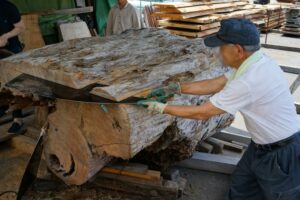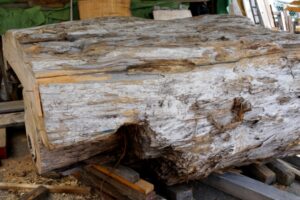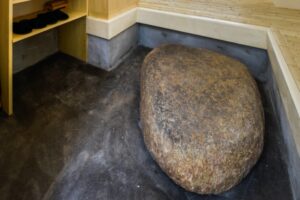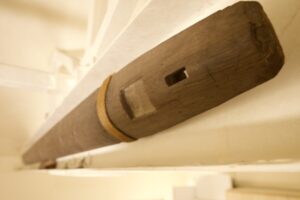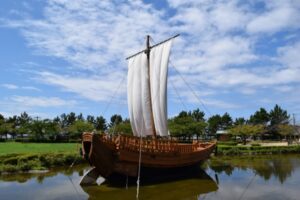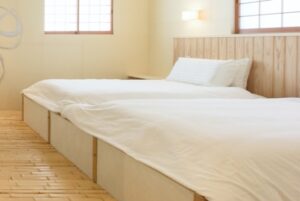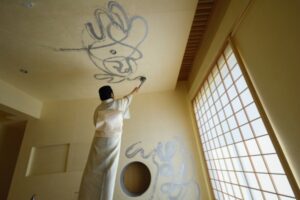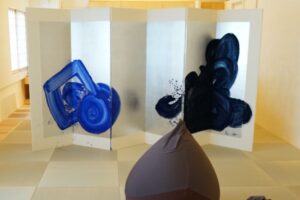Special materials
Yakushima cedar (esp. one over 1000 years old)
A Yakusugi cedar from Yakushima Island, a World Heritage Site, is the centerpiece of the room. The Yakusugi cedar has been banned from logging since 1993, and will be banned from auction from 2019, making it impossible to obtain.
-
This tree is said to have been felled by a typhoon around the late Edo period (1603-1868), and was acquired by a famous old tree dealer at the last auction.
This Yakusugi cedar was cut into pieces by a wood cutter. Using a large saw, it took about two days to get the most beautiful cross section.
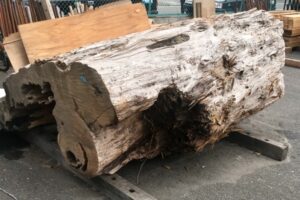
The wood grinder is a traditional profession that only a few people in Japan have, and it has an excellent eye for reading wood. They have an excellent eye for reading wood, so they know how to grind the wood to get the most beautiful surface, and create the best lumber for the tree.
Kutsunugiishi (Shoes of Kurama Stone)
Kurama stone, which is characterized by its reddish-rust color, is used for the front door shoes. Kurama stone is mined on Mt. Kurama in the northern part of Kyoto, but since good quality stone is not produced there anymore, it is valued as a precious stone material.
-
Kurama stone contains iron, which rusts when it gets wet. In addition, the word “sabi” is used to describe the taste of old age, and “sabi”, along with “wabi”, is considered to be a philosophy of the tea ceremony.
For this reason, Kurama stone is closely associated with the tea ceremony as a ” stone of wabi-sabi ” and was used for garden stones and stepping stones.
Rudder pattern of the Kitamae Oyakata ship
Kitamaebune is a merchant ship that contributed to the development of the Japanese economy and culture as a moving general trading company around the Edo period. An authentic rudder pattern used in those days is displayed on the second floor ceiling.
-
The rudder pattern is carved to wish for safety, security, and happiness.
<What is the Kitamae Ship?
Kitamae-bune is a generic name for merchant ships that traveled from the mid-Edo period to the Meiji period (1868-1912), The Kitamae-bune is a generic name for merchant ships that traveled mainly between Osaka and Hokkaido The Kitamae-bune is a generic name for merchant ships thatOn April 28, 2009, the Agency for Cultural Affairs recognized the “Port of Call of Kitamae Ship” as a Japan Heritage Site. The registered areas are 11 cities and towns in 7 prefectures from Hokkaido to Hokuriku.
The photo shows a one-half-size reconstruction of a Sengoku-bune (Kitamae-bune).
In Hiyoriyama Park in Sakata City Hiyoriyama Park It is the largest existing model in Japan.
tatami mat with a flat surface
The stairs and the hall on the second floor all use modern tatami without edges. These tatami mats have been gaining attention in recent years and are very popular.
-
The corners are also made of mokuzumi weave to make a durable table of rushes.
As the name suggests, ” edgeless tatami”, which has been gaining popularity in recent years, refers to tatami without edges. It is processed by using a tatami mat board wider than the one normally used, and folding it in all directions while rolling it up and meeting it. Edge-less tatami itself is not a recent development, but a traditional tatami production method represented by Ryukyu tatami.
The reason why “edgeless tatami” is more expensive than general edgeless tatami is that it is difficult to adjust the size and processing techniques, the production volume per day is small, and the price of materials is higher than that of general tatami.
Bamboo Floor
The floor is covered with 4 cm wide bamboo, which is said to have been used for the bamboo fence of Kenninji Temple in Kyoto, and was designed to make the summer in Kamakura comfortable from the feet up.
-
The bamboo fence of Kenninji Temple is made by splitting round bamboos into long and thin boards, laying them upright with no gaps, and then holding them together with oshimaru made of the same bamboo material.
There are two types of bamboo fences: “openwork fence” like the Yotsume fence, and “shielding fence” that hides the back of the fence. Kenninji fence is the most popular type of shielding fence.
Bedding made of natural materials
The mattresses on the first floor are horsehair mattresses, which are the best natural material with excellent elasticity, air permeability, moisture absorption and desorption, all of which are difficult to obtain, allowing you to experience the ultimate in sleeping comfort.
-
On the second floor, we have a combination of Airwave, which provides comfortable sleeping, and Futon Elements, developed by Hüsler Nest of Switzerland to suit the Japanese style, with bedding for up to eight people on the first and second floors combined.
Ishidaya’s horsehair mats, a long-established product since 1923, are very attractive for their exquisite sleeping comfort that looks hard but is not. The strong curl of the finest horsehair material is created through the process of unraveling, braiding into ropes, steaming, drying, and unraveling again, and its elasticity is outstanding. Horsehair bedding is durable enough to last a hundred years, making it a first-class product that can be passed on to the next generation.
Horsehair is one of the best bedding materials in terms of breathability, moisture absorption, and moisture release. It absorbs moisture at a rate of about 50 liters for a single size mattress. With its strong elasticity, it can maintain sufficient air permeability even when the full weight and pressure of the sleeper is applied.
The futon mattresses provided on the second floor are made of Airwave, an 8cm thick air fiber that supports the entire body for a comfortable sleeping experience. We also offer the ultimate in wood springs, the Futon Element. The Futon Element is a product developed by Hüssler Nest in Switzerland to suit the Japanese style of sleeping with a mattress. By simply placing it under the mattress, you can maintain the perfect balance of sinking your waist and shoulders but not your waist.
Natural Japanese paper wall
Echizen washi, a traditional craft of Fukui Prefecture, is made into 300 sheets the size of tatami mats and applied to the entire interior.
-
Unlike industrial products, there is no need to worry about the release of chemical substances. By applying natural Japanese paper indoors, lighting will be gentler on the eyes and sound absorption will have a relaxing effect.
Echizen washi is made in the Imadate district of Echizen City (formerly Imadate Town) in Fukui Prefecture, and continues to be produced as the nation’s leading producer of washi in terms of quality, variety, and quantity.
Echizen-bonsho and Echizen-torinoko-gami are designated as Important Intangible Cultural Properties of Japan.
From the Edo period (1603-1868) to the Meiji, Taisho, Showa and Heisei periods (1868-1912), the demand for fusuma paper in Echizen dominated the nation. It is said that in 1665, permission was granted to use the seal “Ojo Tenka-ichi” on Echizen-bosho.
Creation of Harmony
document
The calligraphy on the walls and ceilings is done by the calligrapher Rieko Kawabe.
-
The depicted “mawariuta” is a waka poem that can be read from above or below, and is considered to be a good omen for wishes to come true.
First floor: I asked the participants to write in the Jindai script the waka poem “Nagaki yoru no tono nefuri no minamasame namori fune no oto no yoki kana” (Long Night of Distant Sleeping, Everyone Awakens, Sound of Surfing Boat), which was written in the Muromachi period, an era when Japanese culture was finally brewing.
Second floor: For the folding screen, I had “Senyo” written in bright blue and dark blue, using the two expressions of the sea.
Please enjoy the beauty of Japan conveyed through calligraphy and the presentation of Japanese space to the fullest.
Rieko Kawabe’s official website
https://www.riekokawabe.com
Special materials
The 2,000-year-old Yakusugi cedar
A Yakusugi cedar from Yakushima Island, a World Heritage Site, is the centerpiece of the room. The Yakusugi cedar has been banned from logging since 1993, and will be banned from auction from 2019, making it impossible to obtain.
This tree is said to have been felled by a typhoon around the late Edo period (1603-1868), and was acquired by a famous old tree dealer at the last auction.
-
This Yakusugi cedar was cut into pieces by a wood cutter. Using a large saw, it took about two days to get the most beautiful cross section.

The wood grinder is a traditional profession that only a few people in Japan have, and it has an excellent eye for reading wood. They have an excellent eye for reading wood, so they know how to grind the wood to get the most beautiful surface, and create the best lumber for the tree.
Kutsunugiishi (Shoes of Kurama Stone)
Kurama stone, which is characterized by its reddish-rust color, is used for the front door shoes. Kurama stone is mined on Mt. Kurama in the northern part of Kyoto, but since good quality stone is not produced there anymore, it is valued as a precious stone material.
-
Kurama stone contains iron, which rusts when it gets wet. In addition, the word “sabi” is used to describe the taste of old age, and “sabi”, along with “wabi”, is considered to be a philosophy of the tea ceremony.
For this reason, Kurama stone is closely associated with the tea ceremony as a ” stone of wabi-sabi ” and was used for garden stones and stepping stones.
Rudder pattern of the Kitamae-bune Oyakata ship
Kitamaebune is a merchant ship that contributed to the development of the Japanese economy and culture as a moving general trading company around the Edo period. An authentic rudder pattern used in those days is displayed on the second floor ceiling.
The rudder pattern is carved to wish for safety, security, and happiness.
-
<What is the Kitamae Ship?
Kitamae-bune is a generic name for merchant ships that traveled from the mid-Edo period to the Meiji period (1868-1912), The Kitamae-bune is a generic name for merchant ships that traveled mainly between Osaka and Hokkaido The Kitamae-bune is a generic name for merchant ships thatOn April 28, 2009, the Agency for Cultural Affairs recognized the “Port of Call of Kitamae Ship” as a Japan Heritage Site. The registered areas are 11 cities and towns in 7 prefectures from Hokkaido to Hokuriku.
The photo shows a one-half-size reconstruction of a Sengoku-bune (Kitamae-bune).
In Hiyoriyama Park in Sakata City Hiyoriyama Park It is the largest existing model in Japan.
tatami mat with a flat surface
The stairs and the hall on the second floor all use modern tatami without edges. These tatami mats have been gaining attention in recent years and are very popular.
The corners are also made of mokuzumi weave to make a durable table of rushes.
-
As the name suggests, ” edgeless tatami”, which has been gaining popularity in recent years, refers to tatami without edges. It is processed by using a tatami mat board wider than the one normally used, and folding it in all directions while rolling it up and meeting it. Edge-less tatami itself is not a recent development, but a traditional tatami production method represented by Ryukyu tatami.
The reason why “edgeless tatami” is more expensive than general edgeless tatami is that it is difficult to adjust the size and processing techniques, the production volume per day is small, and the price of materials is higher than that of general tatami.
Bamboo Floor
The floor is covered with 4 cm wide bamboo, which is said to have been used for the bamboo fence of Kenninji Temple in Kyoto, and was designed to make the summer in Kamakura comfortable from the feet up.
The bamboo fence of Kenninji Temple is made by splitting round bamboos into long and thin boards, laying them upright with no gaps, and then holding them together with oshimaru made of the same bamboo material.
-
There are two types of bamboo fences: “openwork fence” like the Yotsume fence, and “shielding fence” that hides the back of the fence. Kenninji fence is the most popular type of shielding fence.
Bedding made of natural materials
The mattresses on the first floor are horsehair mattresses, which are the best natural material with excellent elasticity, air permeability, moisture absorption and desorption, all of which are difficult to obtain, allowing you to experience the ultimate in sleeping comfort.
On the second floor, we have a combination of Airwave for comfortable sleeping and Hutong elements developed by Hüsler Nest in Switzerland, with bedding for up to 8 people on the first and second floors combined.
-
Ishidaya’s horsehair mats, a long-established product since 1923, are very attractive for their exquisite sleeping comfort that looks hard but is not. The strong curl of the finest horsehair material is created through the process of unraveling, braiding into ropes, steaming, drying, and unraveling again, and its elasticity is outstanding. Horsehair bedding is durable enough to last a hundred years, making it a first-class product that can be passed on to the next generation.
Horsehair is one of the best bedding materials in terms of breathability, moisture absorption, and moisture release. It absorbs moisture at a rate of about 50 liters for a single size mattress. With its strong elasticity, it can maintain sufficient air permeability even when the full weight and pressure of the sleeper is applied.
The futon mattresses provided on the second floor are made of Airwave, an 8cm thick air fiber that supports the entire body for a comfortable sleeping experience. We also offer the ultimate in wood springs, the Futon Element. The Futon Element is a product developed by Hüssler Nest in Switzerland to suit the Japanese style of sleeping with a mattress. By simply placing it under the mattress, you can maintain the perfect balance of sinking your waist and shoulders but not your waist.
Natural Japanese paper wall
Echizen washi, a traditional craft of Fukui Prefecture, is made into 300 sheets the size of tatami mats and applied to the entire interior.
Unlike industrial products, there is no need to worry about the release of chemical substances. By applying natural Japanese paper indoors, lighting will be gentler on the eyes and sound absorption will have a relaxing effect.
-
Echizen washi is made in the Imadate district of Echizen City (formerly Imadate Town) in Fukui Prefecture, and continues to be produced as the nation’s leading producer of washi in terms of quality, variety, and quantity.
Echizen-bonsho and Echizen-torinoko-gami are designated as Important Intangible Cultural Properties of Japan.
From the Edo period (1603-1868) to the Meiji, Taisho, Showa and Heisei periods (1868-1912), the demand for fusuma paper in Echizen dominated the nation. It is said that in 1665, permission was granted to use the seal “Ojo Tenka-ichi” on Echizen-bosho.
Creation of Harmony
A Brush Connecting Heaven and Earth
The calligraphy on the walls and ceilings is done by the calligrapher Rieko Kawabe.
The depicted “mawariuta” is a waka poem that can be read from the top or the bottom, and is considered to be a good omen for wishes to come true.
-
First floor: I asked the participants to write in the Jindai script the waka poem “Nagaki yoru no tono nefuri no minamasame namori fune no oto no yoki kana” (Long Night of Distant Sleeping, Everyone Awakens, Sound of Surfing Boat), which was written in the Muromachi period, an era when Japanese culture was finally brewing.
Second floor: For the folding screen, I had “Senyo” written in bright blue and dark blue, using the two expressions of the sea.
Please enjoy the beauty of Japan conveyed through calligraphy and the presentation of Japanese space to the fullest.
Rieko Kawabe’s official website
https://www.riekokawabe.com

